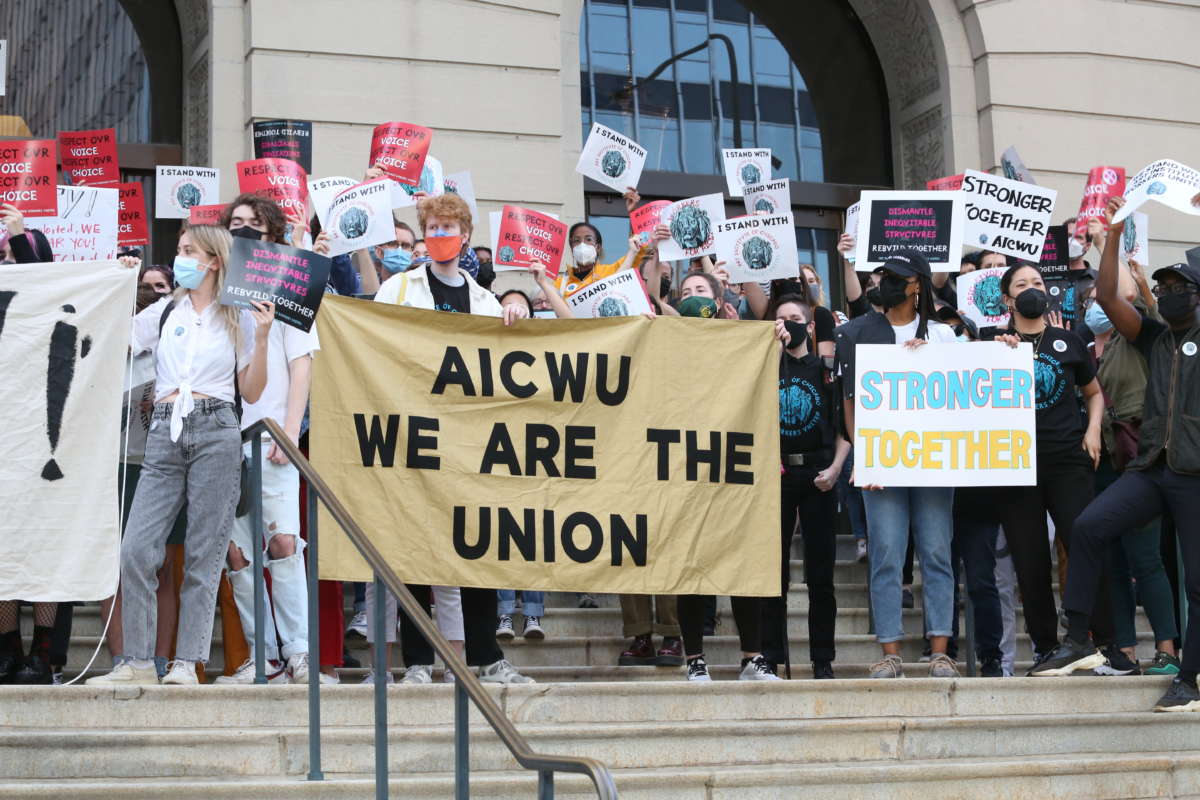In the past two years, cultural workers around the U.S. — including those who work in the arts and at cultural institutions like museums and libraries — have joined a burgeoning unionization movement, seeking a means to better wages, greater transparency and a seat at the table with management.
So far in 2021, employees at the Guggenheim Museum, the Brooklyn Museum and the Massachusetts Museum of Contemporary Art (Mass MoCA) have all voted to unionize, with workers at several other institutions — such as the Art Institute of Chicago (AIC) and its adjoining school and the Walters Art Museum — in the process of organizing. They follow workers at institutions ranging from the Whitney Museum to the Museum of Fine Art in Boston and Seattle’s Frye Art Museum, which all led successful unionization campaigns in 2019 and 2020.
“We started a wave of organizing with both the New Museum and Brooklyn Academy of Music; this was all pre-pandemic,” says Maida Rosenstein, president of United Auto Workers (UAW) Local 2110, a union for technical, office and professional workers. “I think a lot of workers at museums [and] cultural institutions were turning toward organizing as a way of addressing, in part, real, huge pay gaps between those at the top and the staff. During the pandemic, people paid even more attention because museums shut down; there were furloughs and layoffs. And workers realized that they had little to no job security in addition to low pay.”
These were some of the concerns of employees at AIC and the School of the Art Institute of Chicago (SAIC), who announced their intention to unionize with AFSCME Council 31 in August. Thomas Huston, a museum technician, credits the pandemic with not only helping to highlight some ongoing labor issues but also allowing employees to make connections and realize how widespread those issues were.
Robyn Besana, a disability advocate at SAIC, wants to unionize to better hold the school accountable for its own ideals. “I am really interested in organizing because, as a woman of color, I want to hold SAIC management and upper administration accountable to making SAIC a truly anti-racist school, and not just a performative one,” she told Truthout.
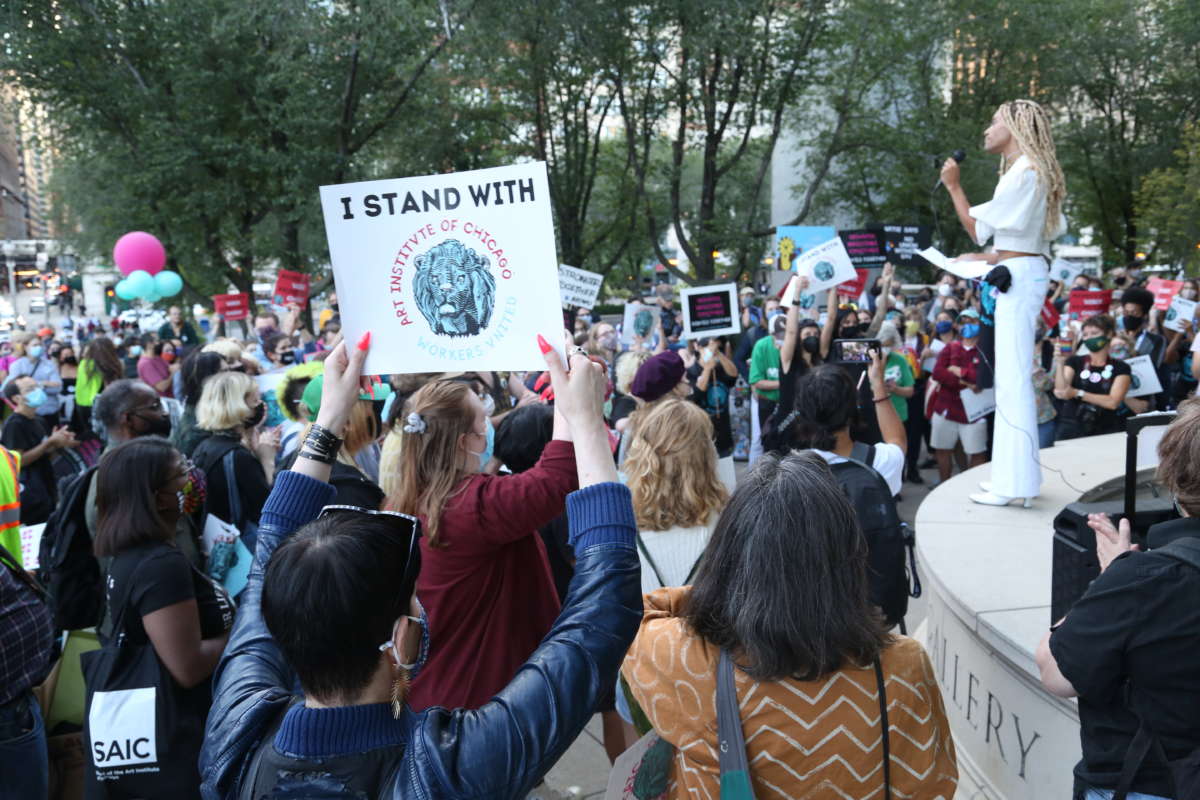
Last year, after the murder of George Floyd led to renewed calls for racial justice, SAIC formed an anti-racism committee to make recommendations for change. Besana was invited to join the committee, and was initially very invested in the work.
“I became quickly disillusioned when I learned that having a direct line to upper administration is not the same as having shared governance and shared decision making with upper administration,” she says. After months of meetings, for which staff did not receive additional compensation, she says the committee’s recommendations were watered down without explanation. For example, some committee members noted how infrequently the word “anti-racism” appeared in the final recommendations. Instead, there were suggestions such as a diversity course requirement, in place of an anti-racism course requirement. While diversity is important, Besana says, it “is nowhere near the same as dismantling the systems that uphold racism.”
“I’m really hoping that our union will be able to establish a structure that is transparent and also we will have the legal right to negotiate this with management and upper administration,” she says, “so we can truly make some change instead of a lot of talking and a lot of performative value signaling.”
However, the Art Institute is not making the unionization effort easy, according to organizers.
According to an August 25 press release from the organizing committee Art Institute of Chicago Workers United (AICWU), “AIC/SAIC senior leadership has hired the management-side law firm of Cozen O’Connor and the PR consultancy Reputation Partners” to fight the unionization effort. The press release notes that in earlier cases involving contracts with other companies, Cozen O’Connor lawyers billed between $315 and $430 an hour back in 2017, and in 2019, Reputation Partners billed from $325 to $390 per hour.
“They didn’t have enough money to keep staff members and now they seem to have enough money to retain law firms and PR companies,” Besana says. “I would love transparency when it came to hiring and firing, and what money we have for what.”
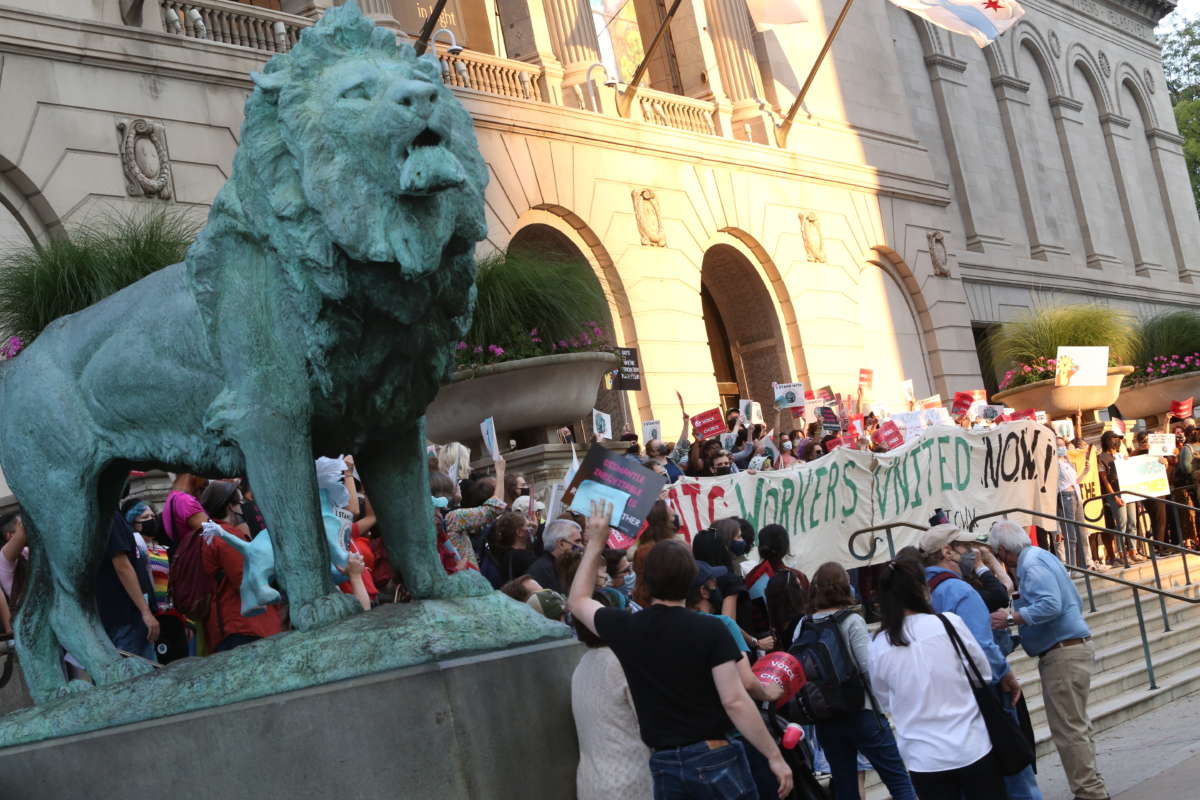
Since 2020, the Art Institute laid off 76 people and furloughed over 100 more, while SAIC eliminated dozens of full-time, part-time and contract workers.
AIC leadership did not respond to requests for comment.
In addition to the PR and law firm retention, AICWU workers say management have been sowing misinformation, framing the union as an outside, third-party entity and falsely telling some employees they are managers, and thus ineligible for unionization. “The way they describe how eligibility will be determined, folks walk away thinking that SAIC will be the organization that determines eligibility,” Besana says. In fact, the National Labor Relations Board (NLRB) makes the final determination, if workers and management cannot come to an agreement.
Workers at the Walters Art Museum in Baltimore say that management has also sought to undermine their organizing efforts. In a letter posted to the museum’s website in June, museum director Julia Marciari-Alexander and members of the board wrote that while the museum “supports the rights of employees to choose whether to unionize,” it would not voluntarily recognize the union. Voluntary recognition is the easiest route for a workplace to take if a majority of employees have expressed interest in unionizing, which they have, according to museum security officer Garrett Stralnic. It is quicker than an NLRB or third-party election and fairer to employees, if a strong majority have already signed union cards. About 90 Walters employees are eligible to join the union. The organizing committee, Walters Workers United, hopes to form a wall-to-wall union with AFSCME Council 67, including workers in security, education, marketing and retail, among other departments.
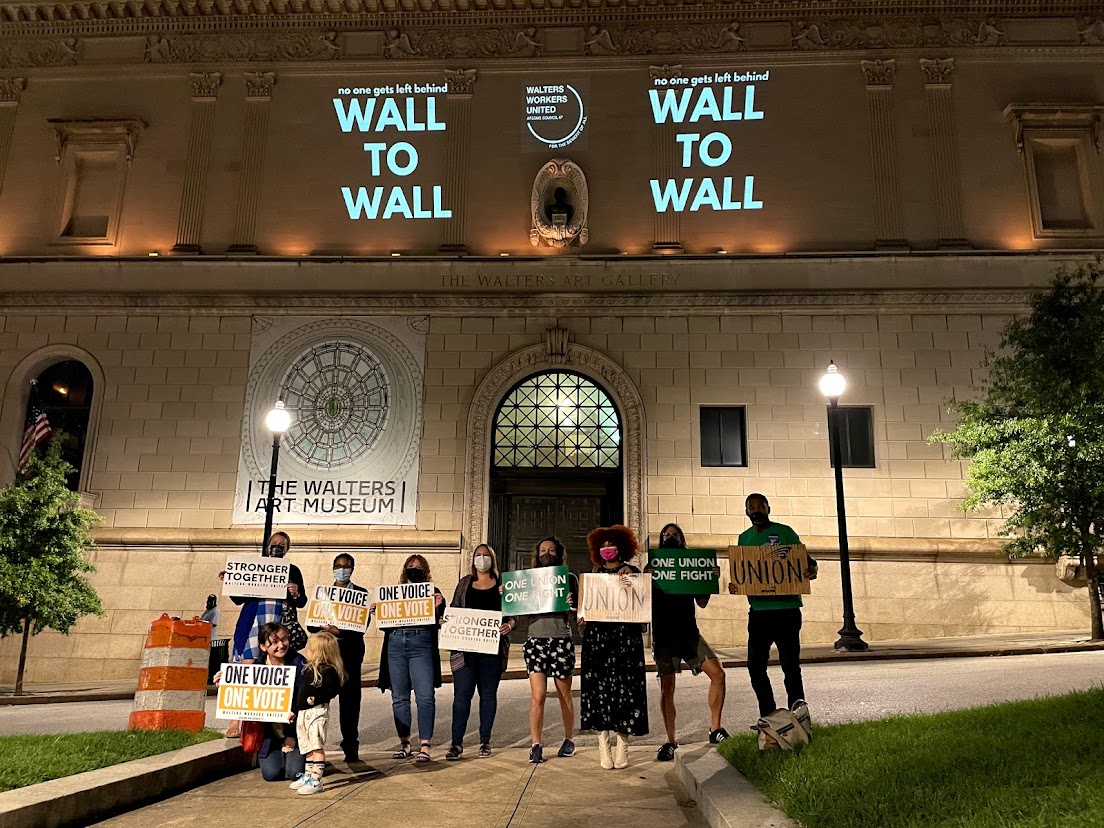
Marciari-Alexander has indicated that she is waiting for employees to hold a vote with the NLRB, which she wrote in a more recent public letter, “is the only mechanism to ensure that each member of our staff is properly heard on the question of whether to have a union.” (Marciari-Alexander did not respond to requests for comment.) Yet workers say that an NLRB election is not appropriate for this union, as it would exclude security and gallery officers under the NLRB’s “mixed-guard rule,” limiting workers’ bargaining power. Another option is to hold a vote through a neutral third party, such as the American Arbitration Association, which Baltimore’s Open Society Institute, an organization which shares some board members with the Walters, used for a union election. In order to pursue this option, staff and management would have to meet and come to an agreement. Stralnic says that the director refuses to meet.
Allison Gulick, a former employee in the learning and community engagement department, says the museum director is framing her push for the NLRB vote as a way to ensure people have the right to vote for or against the union. “But it’s pushing for the right to vote with a secret agenda,” Gulick says.
Another primary concern is health and safety. In June, staff were unknowingly exposed to harmful organic vapors during roof repairs. It wasn’t until June 11, when nearly 50 staff wrote a letter to museum leadership, describing staff symptoms of “sore throats, dizziness, nausea, headaches, and other respiratory issues” that the museum investigated the situation. According to a Baltimore Sun article, a June 15 inspection by an industrial hygienist hired “detected dangerously high levels of the chemicals from a sealant being used on the roof.” The museum was subsequently closed to the public for three weeks.
“I just felt kind of trapped,” Stralnic says, of working with the vapors. People had been raising the issue of the vapors for over a week, individually reporting side effects. “I really want the union, I’ll just feel safer,” he says, “if we have more of a voice when it comes to our safety.”
Gulick says sudden staff reorganization and termination is another reason to unionize. “We’re just expected to fall in line and sort of make it work,” she says. Her department went from 15 employees to around three people over the more than five years she worked there due to terminations, turnover and budget cuts. Even with the limited staff in the department, Gulick says no programming has been cut.
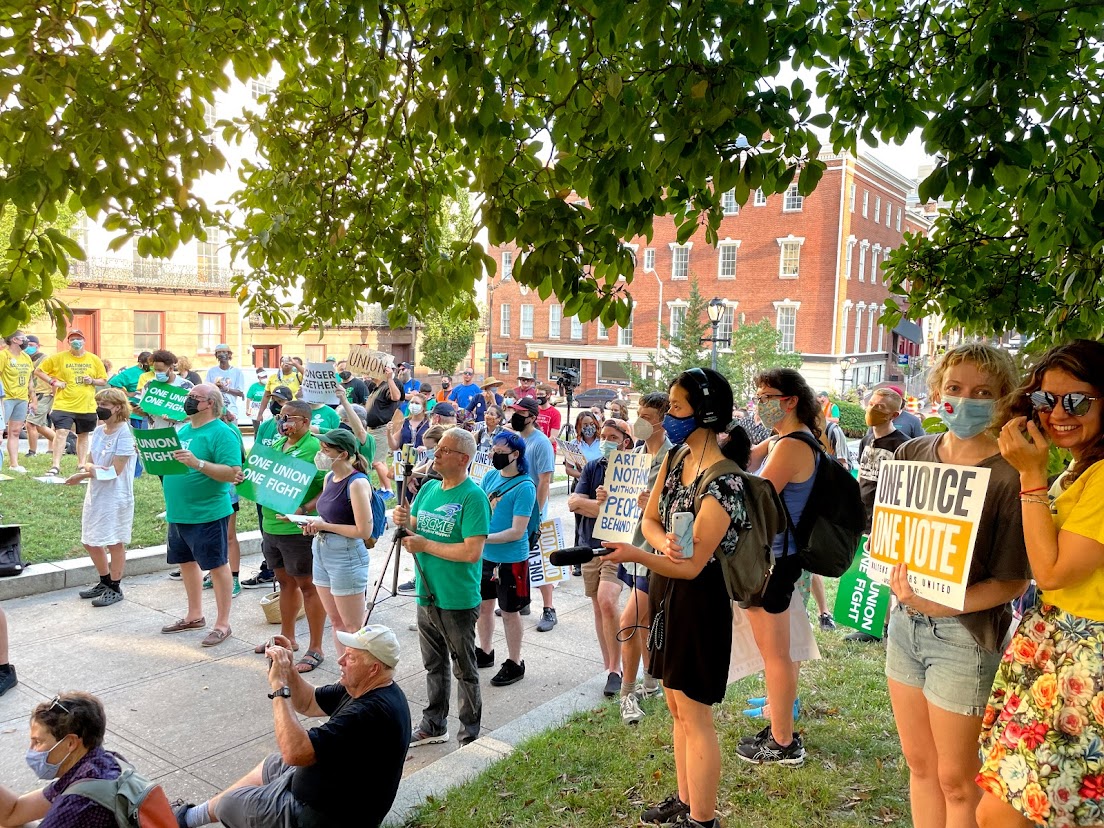
At the Brooklyn Museum, where workers voted to join the UAW Local 2110 in August, management was not outwardly antagonistic to the effort. “The Brooklyn Museum expressed that they did not want to run a campaign against the union,” says Rosenstein, the Local 2110 president. “I think they are still attempting to limit the impact of unionization. What we’ve seen in a lot of these campaigns is attempts to winnow the size of the union down. Keep as many positions out of the union as can be justified.” About 110 workers will be a part of the union.
The Brooklyn Museum did not respond to a request for comment.
Rosenstein credits both the younger generation, which tends to be more pro-union, and the pay inequality at cultural institutions as reasons more and more cultural workers are looking to unionize. “The museum leadership or the top administration at universities are earning very high salaries often,” she says. “Yet the people on staff who are doing the day-to-day work are often low-paid or in very precarious situations. Using part-time workers and seasonal staff and intermittent staff is absolutely common throughout museums. I think it sets up a dynamic to start with that people are likely to challenge, especially when the rents are so high. You’re talking New York City, Boston, Chicago — expensive places to live.”
These issues definitely ring true for AICWU organizers. “We’re really looking at things like equity and pay equity for all people. We’re looking at the ability to see job description transparency and pay transparency,” says Eala O’Sé, an assistant manager of material source at SAIC. “This is the only option that makes sense for us, because of all the issues that we’re facing together. It just makes sense for us all to unite under this cause and really try to figure out what we can do collectively that we haven’t been able to do individually.”
Huston agrees, pointing to AIC’s place in a growing surge of cultural worker unionization.
“There is a real movement across the country: museums organizing, art institutions and cultural organizations organizing,” he says. “This is the time that this is going to really happen. I think we’re all feeling the energy and the momentum.”
Press freedom is under attack
As Trump cracks down on political speech, independent media is increasingly necessary.
Truthout produces reporting you won’t see in the mainstream: journalism from the frontlines of global conflict, interviews with grassroots movement leaders, high-quality legal analysis and more.
Our work is possible thanks to reader support. Help Truthout catalyze change and social justice — make a tax-deductible monthly or one-time donation today.
